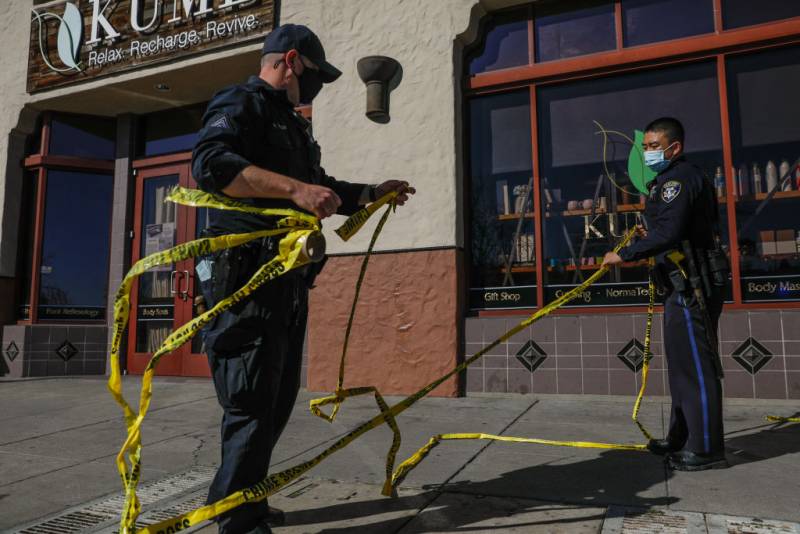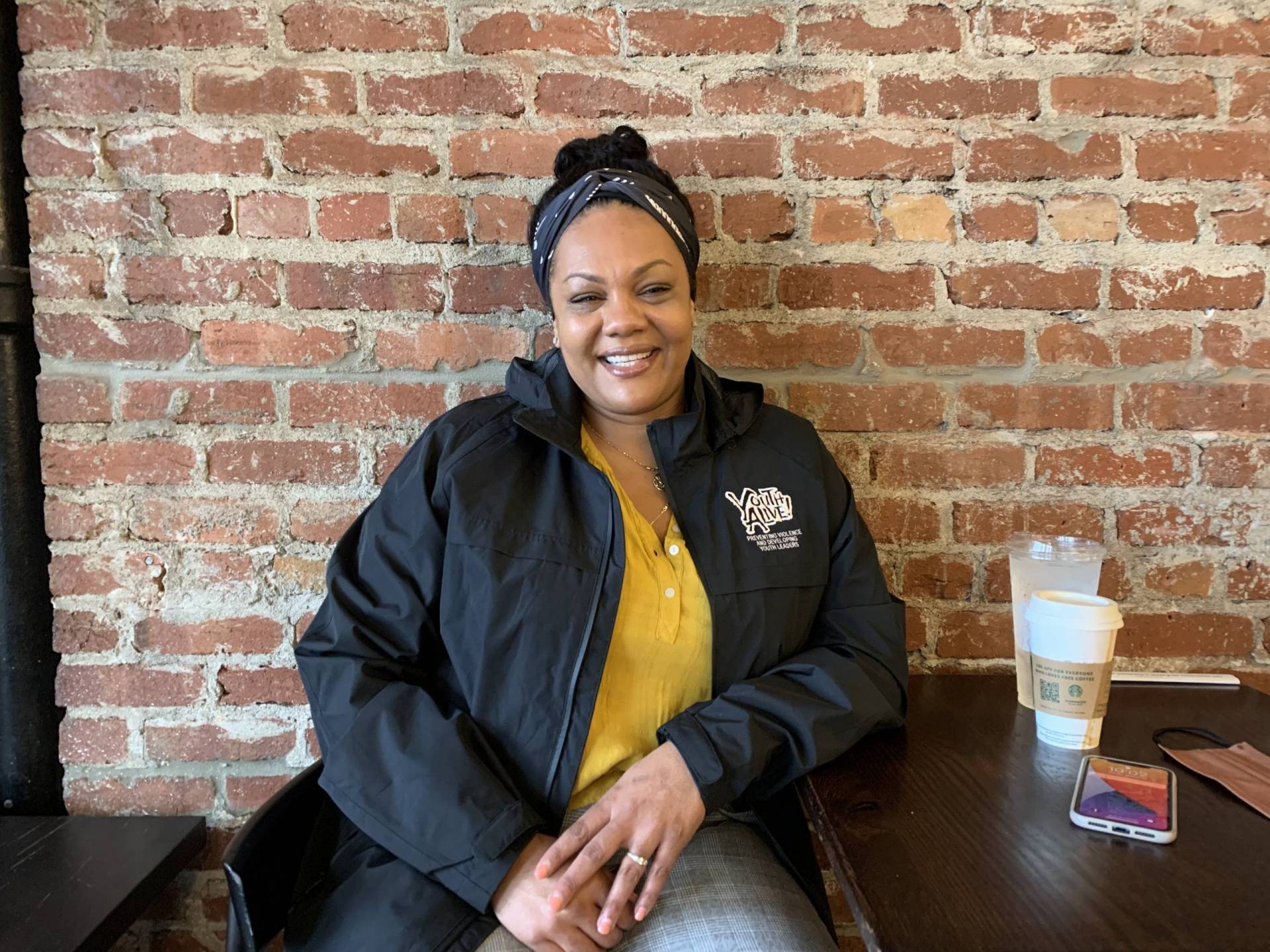“So we’re not seeing a spreading out of violence to other population groups — the elderly, for example — or into affluent communities,” he added. What we’re seeing is an intensification of the violence in the very communities where historically it’s been quite high.”
Jasmine Hardison has experienced that heartbreaking reality firsthand — it’s her job to show up at the scene of homicides in Oakland, and help family members and other survivors cope. Hardison lost her own son to gun violence in 2016 and now works for Youth ALIVE!, a violence prevention nonprofit in the city, as program coordinator for the Khadafy Washington Project.
Oakland, which has long struggled with gun violence, recorded the biggest jump in murders in the Bay Area during the pandemic — an increase that actually began in the city pre-pandemic, in 2019, and continued to rise into 2021. The 2021 per-capita murder rate in Oakland dwarfs that of any other city in the region — it’s nearly double the rate of the next closest cities, Richmond and Vallejo, according to data tabulated by The San Francisco Chronicle.
Hardison said there’s no one factor that seems to be driving Oakland’s increase in violence — though she notes it’s disproportionately affecting the same Black and Brown communities that have long borne the brunt of crime spikes.
She doesn’t believe that more or fewer police on the streets is the answer. Instead, she said she’d like to see officers work more closely with the community.
“I do think that we need to build better relationships,” Hardison said, “because a lot of times [the police department] doesn’t even have that interaction with the community until there’s a homicide. And then at that time, everyone is pretty much treated like a criminal.”
Not as simple as left or right politics
Hardison’s observations speak to what some see as the oversimplification of the issue — one they say both sides in the political debate are getting wrong.
“We appear to be coming down off just a truly momentous increase in violence that can’t be washed away by reformers,” Rosenfeld said. “It can’t be willy-nilly attributed to progressive policies. It’s far more widespread than either of those explanations can handle.”
Rosenfeld said the current political debate over crime is dismaying because both progressives and conservatives are guilty of reducing a complex and tragic situation to political talking points.
“On the one hand, we have people who would abolish the police, whatever that could possibly mean, or greatly defund the police,” he said. “On the other hand, we have those who argue that every time there’s a crime increase, it just has to be related to the election of a progressive prosecutor or the appointment of a progressive police chief or liberals run amok in the policy circles in the city.”
To understand this debate in California, you need to look back at how things have changed the past few decades. Until about 10 years ago, California embraced a more conservative, law-and-order approach to criminal justice that leaned heavily on long prison sentences and resulted in overcrowded state prisons. After a U.S. Supreme Court decision ordering the state to reduce its prison population, Democratic state leaders began passing reforms aimed at lowering the number of inmates and stressing rehabilitation over punishment.
Much of the backlash against those changes comes from law enforcement and the state’s Republican politicians. For example, police and conservatives have long pushed back against the changes instituted by Proposition 47. The ballot measure, passed by voters in 2014, made most drug possessions a misdemeanor instead of a felony, and directed the state to use the savings (from not imprisoning as many people) on rehabilitation programs. It also brought California in line with most other states by increasing the threshold for misdemeanor shoplifting from $450 to $900.
As brazen shoplifting instances were caught on camera this past year, many opponents of the measure blamed it as a driving factor, saying criminals were taking advantage of what they call the state’s more lenient laws. Critics have also linked reforms like Proposition 47 to violent crime increases.
The rural-urban divide
But statewide data in California reveals that pandemic-related spikes in violence did not spare rural, conservative communities, which in some instances actually experienced relatively larger increases in violent crime during the pandemic than did urban centers with more progressive criminal justice policies.
In California, three tiny rural, conservative counties — Mono, Modoc and Tehama — experienced the largest jumps in per capita murders between 2019 and 2020 (although the actual numbers of murders and other violent crime incidents were still relatively low, as these counties have tiny populations).
Meanwhile, Los Angeles and San Francisco counties — where the progressive-minded top prosecutors are both facing recall attempts — did not see huge spikes in violence.
In larger urban areas, the biggest per capita increases in murders were in Vallejo, Inglewood and San Bernardino — which represent a mix of political leanings.
Rosenfeld and other criminologists say the broader homicide trends are likely driven by a confluence of factors, including the economic woes and broader social disruptions brought on by the pandemic, as well as social unrest sparked in 2020 by the murder of George Floyd. He also attributed the uptick to a pullback in policing due to COVID-19 concerns, staffing shortages and political pressure against aggressive policing practices. Increases in drug sales and use and, possibly, increased access to guns also played a role, he said.
What history tells us
Criminologists say that many factors over the past two years that were related to or caused by the pandemic have historically been linked to an increase in violence.
Among them: the wild fluctuations in the economy since the pandemic began, which hit communities of color especially hard, as well as the nationwide increase in drug use, particularly methamphetamines and fentanyl.
“We know that beginning in the mid ’60s and since then, economic conditions have played a role [in violent crime rates] — in particular, inflation,” Rosenfeld said, noting that as inflation stabilized, so, too, did crime rates. “The crack-cocaine era [of the 1980s and 1990s] saw an increase in violent crime associated with the drug markets of the time. And in research I’ve done and published, the opioid epidemic has also pushed up homicide rates in U.S. counties.”
But there are also factors that are less understood. Take the nationwide racial justice protests in the summer of 2020 that coincided with the increase in homicides. Researchers have tracked since the 1960s the correlation between social unrest — often sparked by conflicts with police — and violent crime, Rosenfeld said.


